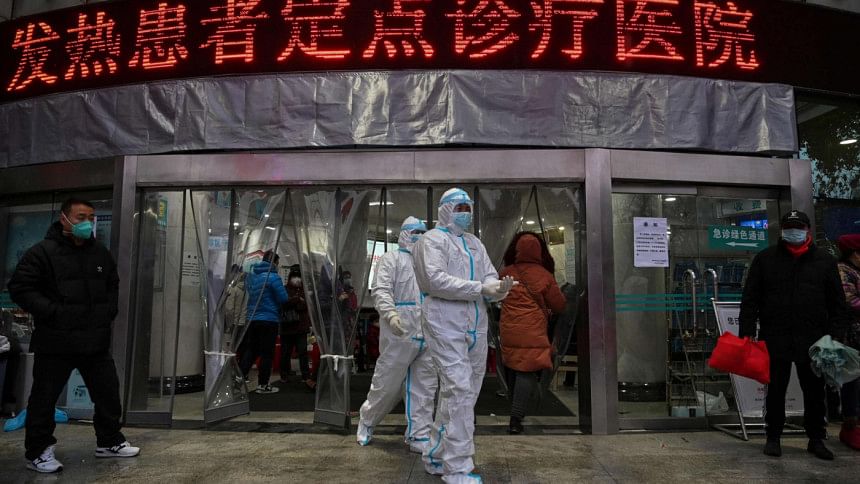The coronavirus threat is far from over

Nearly two decades have passed since a coronavirus known as SARS emerged in China, killing hundreds of people and creating severe panic that sent a chill through the global economy. The new coronavirus spreading across China already appears to be much worse. The outbreak has had a negative impact on the global market, disrupting virtually every major industry, from food and fashion to technology. There is no sign that the devastating economic impact is about to ease up.
Moreover, as the virus spreads in close contact, medical staff are also at risk and are therefore using protective suits while dealing with patients. US government-funded Radio Free Asia (RFA) posted a footage, which shows heartbroken relatives of several doctors sobbing and hugging each other as their loved ones board a staff coach, going on a deadly mission to save the lives of people burdened with the emergence of the alarming viral strain.
Coronavirus, an airborne virus, spreads in a similar way to colds and the flu. It attacks the respiratory system, causing pneumonia. The clinical features include a runny nose, headache, cough, fever and shortness of breath. In most cases, patients would not know whether they have a coronavirus or a different cold-causing rhinovirus. When a coronavirus infection spreads to the lower respiratory tract, it can cause lesion in the lung, more so in older people, people with heart disease or those with compromised immune systems.
The first 2019-nCoV cases reported in December 2019 were traced to Wuhan, the capital of Hubei Province in China with 11 million people. The residents of the city have been under lockdown for a few weeks due to the fatal scenario. To contain the virus, China's government imposed a ban on travel to cut off transport links inside and outside the city.
The World Health Organization on February 11 proposed an official name for the illness caused by the new coronavirus: COVID-19. The acronym stands for coronavirus disease 2019, as the illness was first detected towards the end of last year. The director general of the WHO, Tedros Adhanom Ghebreyesus, noted that the new name makes no reference to any of the people, places or animals associated with the coronavirus and the goal was to avoid stigma. The officials also announced that nearly 15,000 new cases and 242 new deaths were recorded in a single day in Hubei Province, the epicentre of the coronavirus outbreak.
Bioresearchers at the Centers for Disease Control and Prevention are hoping that diagnostic platforms previously used to develop tests for outbreaks of other epidemic respiratory diseases, including SARS and MERS, can be built on to develop new tests to detect cases in the current coronavirus outbreak as stated by US infectious disease authorities. This comes as more patients are monitored around the US for the infection.
Until now, only infections confirmed by specialised testing kits were considered accurate. But those kits have been in such short supply and so many sick people remain untested that the authorities in Hubei have started counting patients whose illness have been screened and identified by the physicians. The result was a sudden and large spike in the overall tally for the coronavirus: more than 1,600 people killed and well over 68,000 infected.
The change in how cases are counted is only one factor that has made it difficult for experts to determine the true scale of the epidemic. Co-Diagnostics, a molecular diagnostics company with a unique, patented platform for the development of molecular diagnostic tests, recently announced that it has completed principle design work for a PCR screening test. The company claims that their platform and the proprietary structure of CoPrimer molecules dramatically enhance the output of molecular diagnostic tests conducted via real-time polymerase chain reaction tests. They noted that it achieves this by creating reactions that are far more specific than competing PCR technologies and 2.5 million times more effective in minimising amplification errors.
One of the most important advantages of the modality is its ability to reliably and accurately differentiate between similar genetic sequences, in order to reduce the likelihood of a false-positive result. Within a month of initial 2019-nCoV reports, the CDC had developed a real time Reverse Transcription-Polymerase Chain Reaction (rRT-PCR) test that can diagnose 2019-nCoV. As time progresses, CDC will share these tests with domestic and international partners through the agency's International Reagent Resource.
As far as treatments, broad-spectrum antivirals—including remdesivir as well as lopinavir have shown promise against MERS-CoV in animal models and are also being assessed for activity against 2019-CoV, the bioresearchers emphasised.
As there is no vaccine for coronavirus, right now scientists are trying to accomplish something that was inconceivable a decade ago—to create a vaccine against a previously unknown virus rapidly enough to help end an outbreak of that contagious virus. Nonetheless, they are working to stop the spread of the new coronavirus that has already infected tens of thousands of people, mainly in China, and given rise to a respiratory condition now known as COVID-19. Although making a new vaccine takes longer, new genetic technologies along with thoughtful strategies have made researchers optimistic that they can shorten that time to months and possibly weeks and have a tool by the fall that can slow the spread of the infection. Chinese scientists made genetic sequence from the new coronavirus public in early January, just weeks after the first infections with the virus were reported which prompted several labs to start working on a vaccine.
It is worth noting that vaccines work by educating an individual's immune system to recognise the invading virus while neutralising it.
As it spreads quickly, a densely populated country such as India and Bangladesh can be adversely affected with the possible entry of the virus and its enormous economic and social impact. Though we are fortunate enough to date, we need to be proactive to protect ourselves if it gets loose across the South Asian region.
Dr Iftikhar Ahmed is a WHO Fellow and Head of the Department of Microbiology at Enam Medical College, Savar, Dhaka.

 For all latest news, follow The Daily Star's Google News channel.
For all latest news, follow The Daily Star's Google News channel. 



Comments